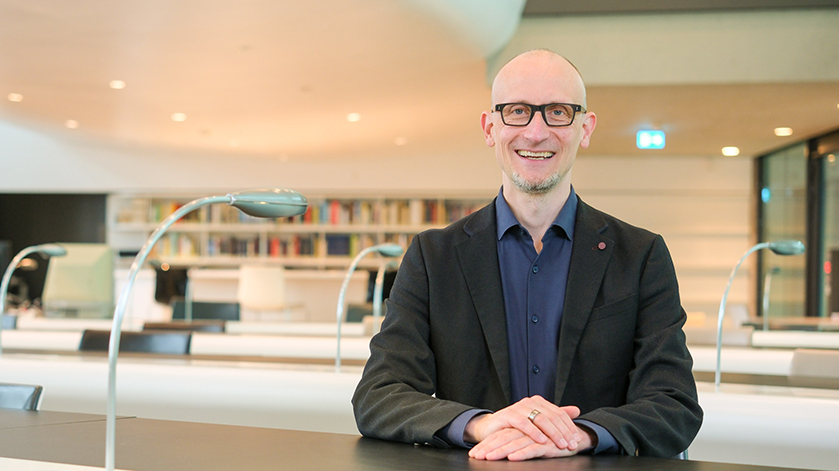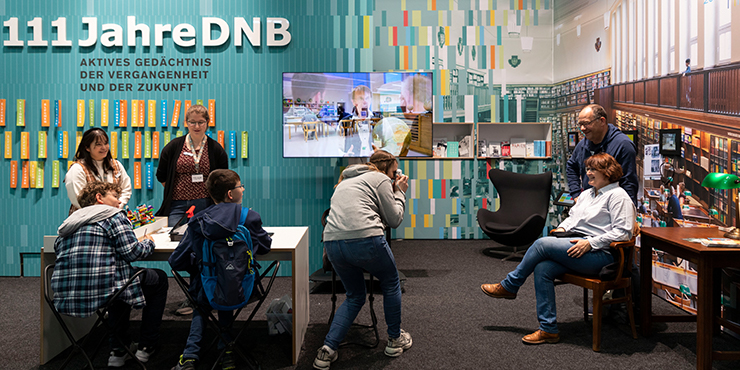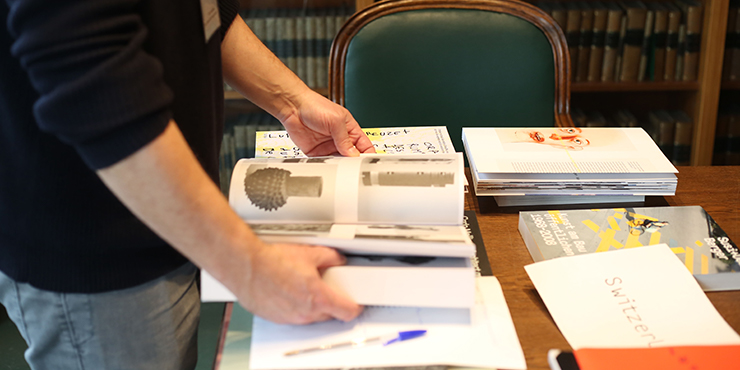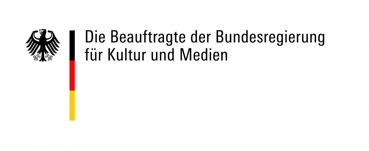New in office: Interview with Johannes Neuer
 Photo: Stephan Jockel
Photo: Stephan Jockel
Mr Neuer, your new year started at the German National Library on 1 August 2023 – your first day as the new director in Leipzig. What has this career change been like for you?
I was thrilled to be able to take up this position! I feel that the first few months have been really positive. My colleagues have been very helpful, patient and open. That was a great experience; the handover from my predecessor, Michael Fernau, also went very well. I am experiencing a steep learning curve, which will continue for some time. Such a large organisation with two locations and more than 600 staff: I need a little time to familiarise myself – with the buildings, the organisation, and of course the people themselves.
It sounds like the DNB has given you a very warm welcome. And how did you find your new start in the city of Leipzig?
I am really very happy to be in Leipzig. I have known the city for more than 30 years and have been here many times. In my view, Leipzig strikes a marvellous balance between nature, culture and the cosmopolitan residents who set the tone for life here. What I like most is that the city is so diverse and colourful. It reminds me a little of my time in New York, even though it is naturally a lot smaller.
Let's move on to the major projects on your desk. Currently right at the top: the fifth extension in Leipzig. What can you tell us about the progress being made?
We have commissioned a final project document. This means we will be able to invite ent-ries for the architectural competition in 2024. We hope to receive attractive, creative proposals for the new stack building, which will provide space for 35.5 million media works. It has to blend in well with the existing group of buildings while making a mark uni-quely its own. It also has to symbolise our commitment to freedom of expression and critical thinking in a democratic society.
So this building will have to reconcile a lot of demands – aesthetic design, functio-nality, and of course of sustainability, which takes priority over everything else. What approach are you taking to this?
Sustainability is nothing new for the German National Library. We had already integrated sustainability considerations such as geothermal probes into the plans for the fourth ex-tension, which opened back in 2011. Sustainability will have an even bigger part to play in the new building. For one thing, we will make sure that it is inert. This means that right from the start, very little energy will be needed to maintain the best possible climatic con-ditions for the long-term preservation of our media. The additional energy required for optimum conditions will then come from sustainable, renewable sources. Parallel to the construction project, we are developing an energy concept for the entire DNB site in Leipzig.
And what will it all look like from the inside?
We are planning to install an automated stack system. However, we have yet to decide what form this will take. The aim is to ensure that each type of media can be archived and delivered to our users with maximum efficiency using largely automated processes.
What would this full automation look like?
At the end of 2023, I paid a visit to "Library and Archives Canada" in Ottawa. There they have robots which take whole shelves from the stacks fully automatically and transport them to an issues area where the staff remove the media requested and send them on to the customer service desk. When the media are no longer required, the system initiates another fully automated process to return them to the stacks. We have something like this in mind for the fifth extension.
In your view, how is the DNB situated in terms of artificial intelligence?
The DNB is very well situated in this respect. More than ten years have passed since we first started using AI in subject cataloguing processes for online publications. Digital media stored on our servers with their metadata are put through a kind of cataloguing machine. This machine reads in the texts and data fully automatically and links them with metadata such as subject categories and GND subject headings which describe their content. This lets users find the works more easily and ensures that they are interlinked by subject. This is very useful for researchers looking for related literature.
So in this respect, libraries can be seen as pioneers in the field of AI?
Not libraries in general, but the German National Library in particular. As the DNB, we take a different approach to AI. Unlike services such as ChatGPT, we train our AI proces-ses in our own system rather than using external data – and this ensures we comply with copyright regulations. This is what distinguishes us from commercial providers, who are currently facing many questions about how far the whole concept is compatible with copy-right legislation.
In your view, what are the current limits of AI with regard to libraries?
Quality is naturally an important consideration. The quality of our AI is already very high. Nevertheless, we are always trying to improve our results by developing our cataloguing machine still further. The barrier we are facing at the moment is that AI is mainly used in connection with digital media. Analogue media are catalogued intellectually, which means that our librarians enter the data into a catalogue system with the help of tools such as the Digital Assistant. We see potential for development in this area. It should also be pos-sible to prepare and catalogue analogue media using AI.
After many years spent working at New York Public Library, you have gained a lot of international experience. Are there any ways in which the DNB can learn from the USA?
Libraries in the USA place even more emphasis on educational formats. This applies to academic and municipal libraries alike – and especially to New York Public Library, which is strongly committed to the education of young people and minorities. It also pursues a strong marketing strategy which gives the library brand a very high profile in society. I think we in Germany can take a leaf out of their book. This also goes hand in hand with the way in which libraries understand themselves. In the USA, they are regarded with pri-de as a wholly organic, vital part of a functional democracy – an aspect we could empha-sise more in Germany. Along with marketing, libraries in the USA also do a lot more fundraising. That takes place in an environment in which more people volunteer or are philanthropically inclined. All the same, I think we could still realise this kind of potential here in Germany.
Taking marketing as a specific example, what potential do you see in this area for the DNB?
There is a whole range of possible approaches. Generally speaking, I would say that we need to raise awareness of the DNB brand throughout Germany as well as at our two lo-cations. I experienced this myself while I was applying for the job. When I told people where I was applying, it was news to many of them that Germany even had a national library. I believe this is exactly where we have to start: by talking about ourselves more – and making others talk about us.
How can you make this happen?
For example by increasing our social media presence still further and expanding our com-munities by posting interesting articles. We have to deliver interesting contributions, not only about our media but also about the values we stand for. We have to expand our dis-tributors and offer more digital resources through our web pages. I'm thinking for examp-le about resources that schoolchildren can use anywhere to research and explore different topics – a kind of citizen science. In other words, so that people work independently and scientifically and enrich our collections with metadata. All these are possibilities we could also offer outside our locations.
Does that mean you also want to increase your appeal for younger target groups?
Yes, and in this context I would like to mention something we achieved in 2023, even though I was not responsible for it. The Administrative Council agreed that we should let people start using the library at the age of 16 rather than 18. This means that even tenth-graders can use our library to write their class papers: a contribution to our mission to reach more younger people.
Your words hint at accessibility and low-threshold services. How exactly do you define these two terms for the DNB?
For me, accessibility firstly means facilitating access for persons with disabilities – to our buildings and to our digital and face-to-face services. However, it also means lowering the threshold to everything we offer. Our fees, for example, have been temporarily suspen-ded so that cost is not a barrier for potential users. I hope this can become permanent. Right now, we are still in the pilot phase, which will continue until the end of February 2025. Another way to lower barriers would be to develop our systems in such a way that they are as easy to use as possible. Our goal in this respect is to improve the catalogue so that it is practically self-explanatory for users.
Finally, were there any other new developments in 2023 which you would like to mention?
One important point was the establishment of our Scientific Service in 2023. Our locations in Leipzig and Frankfurt am Main have two new staff each, who are responsible for net-working with research institutions and reaching out to universities, research centres and individual researchers. In this way, they make our collections and corpora available – also in digital formats – to the persons responsible for creating knowledge. This is an out-standing new development which we are really proud of and would like to build on.
Last changes:
04.06.2024





